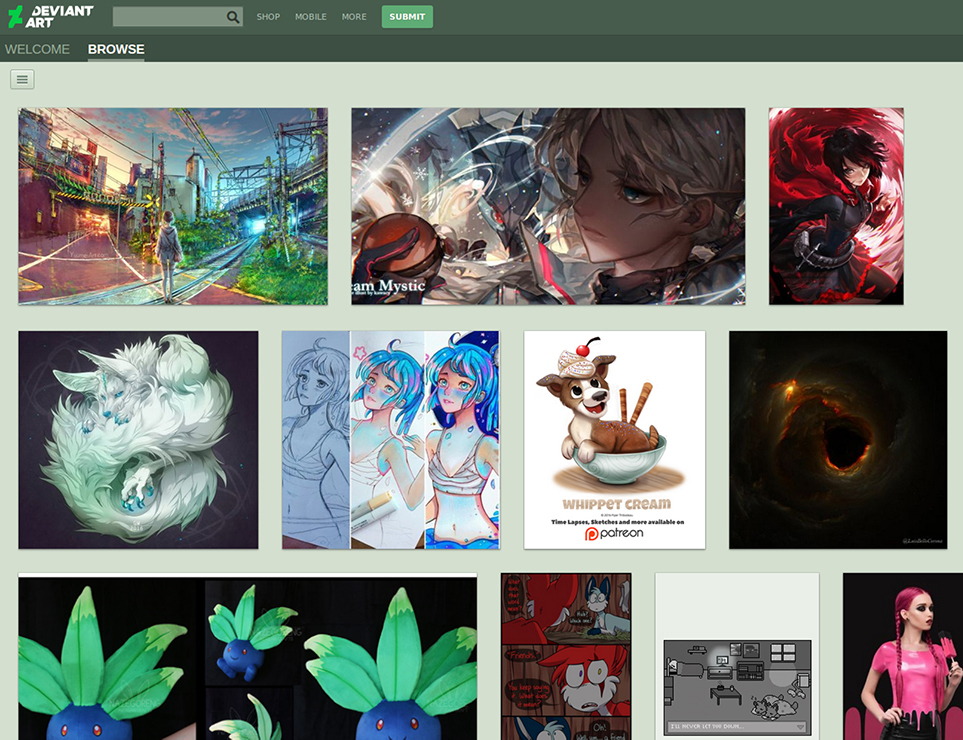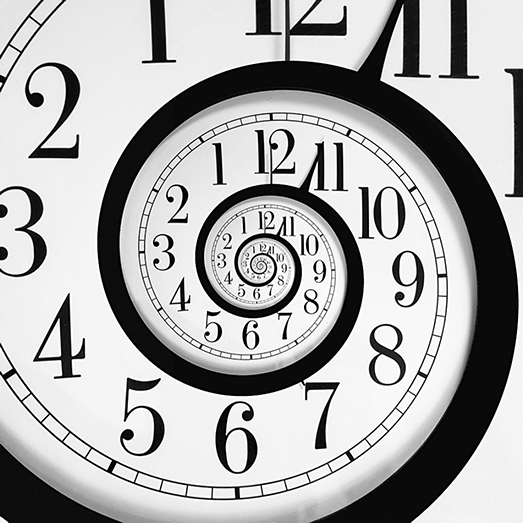CHAPTER 4
Making and Sharing Art
One can make art for oneself, but the vast majority of it is made with the express purpose of being shared with others. Because of this, there is a thriving online art community—as if you lived in Bohemia during its height of art inspiration. Artists can meet online and share their work; give each other comments, constructive criticism and critiques, and motivation to improve; teach each other; and be inspired by each other’s work. Some artists even share their art in steps so that others can learn from it. This is particularly helpful when you are just learning to draw or paint. Perhaps most important, being surrounded (albeit virtually) by other like-minded artists can be a lot of fun.
The largest online community is Deviantart (www.deviantart.com), which is set up to nurture artists, from newbies to professionals. Deviantart opens up with new art and undiscovered artists, such as that shown in the September 2016 screen shot in Figure 4.1. Each piece of artwork you share automatically comes with a message board so that other artists can comment on your work and you can enable the notification system. It also lets you collect and organize inspiration from others. Every new user gets his or her own homepage, which can be customized nicely with various widgets to show off your work in whatever way you would like to arrange it. You can follow other users or follow their deviations (images), journal posts, and forum posts to allow you to tune your interest level in others. Finally, the site enables you to develop or join existing groups of other artists with similar interests (e.g., techniques or genres) and share and collect artwork. This makes it easy to collect a bunch of cool images to use as the background for your computer, but it is probably best for finding inspiration for your own work as you grow as an artist. Licensing is treated fairly loosely on this website—one should assume that most of it is copyrighted, although Creative Commons licenses can be enabled. The Deviantart community is large and vibrant.
Another good art community that offers honest critiques of your art, if you ask for them, is Concept Art (www.conceptart.org). Although perhaps not as sensitive to your feelings (be tough!), the forum website is information dense. When you join, you make a personal sketchbook thread with a showcase gallery of your work. If you really want to learn and improve your art skills, you can also take fine-art classes called “Level Up.” In addition, the site hosts community activities and challenges, as well as ongoing art discussions.
There are also open-source sites devoted to specific kinds of art, such as Open Game Art (opengameart.org), which helps if you need some art to make your video game cooler—or if you want to help others with their games. One user commented that she likes that there are lots of easily accessible resources for when she gets stuck, no matter how complex her art project.
Figure 4.1 Screen shot of some art posted for comment by the Deviantart community.
If your art interest focuses on computer graphics, CGSociety (www.cgsociety.org) may be a great place for you, whether you are into 2D or 3D art (if you just need some free clip art, then FreeSVG [freesvg.org] has tens of thousands of images for you to look through). CGSociety has a large repository of articles on the digital entertainment industry, their artists, and what is going on in the latest movies and short films. You can post your work in the forums and get good feedback on technical questions and software such as Blender (www.blender.org). Blender is a free and open-source 3D creation suite. Frankly, Blender is crazy! It has everything you need to make a full-scale computer graphics (CG) 3D movie, including modeling, rigging, animation, simulation, rendering, compositing, and motion tracking, even video editing and game creation. For example, consider Sintel (Figure 4.2), which is an independently produced short film initiated by the Blender Foundation, that was initially funded by thousands of internet donations. You can watch the 15-minute film for free (durian.blender.org), and download any of the raw files you need to make a derivative of your own. You can use the characters, backgrounds, scenes, and all the tools that made it because they are also open source.
Members of the open-source sharing community build off of each other. Having access to free software can really expand your horizons. For example, you can doodle or have some fun with your kids using TuxPaint (www.tuxpaint.org), which is an award-winning free drawing program for children ages 3 to 12 (preschool to sixth grade). TuxPaint combines an easy-to-use interface, fun sound effects, and an encouraging cartoon penguin mascot (the Linux penguin Tux), who guides you as you use the program.
Figure 4.2 Blender-created image by Lee Salvemini, Pablo Vazquez, David Revoy, Durian Team, and the Blender Foundation. (CC BY) http://durian.blender.org/wp-content/uploads/2010/09/sintel_cover.jpg from http://durian.blender.org/news/sintel-on-3d-worlds-october-issue/
However, if you are going to do digital art, why not go all the way to the top and use a tool for professionals? You can do this with free and open-source software. For those of you interested in digital art, Krita (krita.org) is a fantastic art program that is totally free. The Krita community aims to make Krita the best painting application for cartoonists, illustrators, and concept artists, and if you spend even a few minutes playing with it, you can see it’s come a long way.
As Jack the Vulture3, a 22-year-old artist, explains, he likes digital art because it offers “So much more freedom. To experiment, to make mistakes, to change things around, to try whatever you can think in your mind without having to make the journey to an art supply store. Especially when you don’t have the money to buy all those paints and canvases.” This makes art accessible to anyone with a tablet or a computer who’s willing to work to create. As Jack points out, “I won’t run out of digital canvases” (krita.org/en/item/interview-with-jack-the-vulture/).
Like most of the best open-source packages, Krita is very customizable. There are scores of brush engines to play with, and a constant deluge of new features is being worked on all the time. Plus, you can even make your own brushes, and the developers are responsive and may include your recommendations in the next update. Krita user David Revoy shows how an open-source free culture might work. He is a fantastic illustrator (as shown by his tutorial that made the image in Figure 4.3).
Revoy also started the Pepper & Carrot project (example in Figure 4.4), a comedy/humor webcomic suited for everyone of every age. Somewhat refreshingly for those with children, there is no mature content and no violence, so you can safely read it to your kids without checking it first. Pepper & Carrot is a free and open-source comic about a little witch and her cat. It is funded only by its patrons; each patron sends a little money for each new episode published and gets a credit at the end of the new episode. Thanks to this system, Pepper & Carrot can stay independent and never has to resort to advertising or any marketing pollution. Without any intermediary between artist and audience, users pay less, and the artist benefits more. All the content produced for Pepper & Carrot (www.peppercarrot.com) is free and available to anyone, and it was made with free/libre open-source software on GNU/Linux. Following the true open-source spirit, commercial usage, translations, fan arts, prints, movies, video games, sharing, and reposts are all encouraged!
Figure 4.3 Aqua Dream by David Revoy. Speed painting using Krita recorded for Youtube (youtube/dsDgtIWXLXE). (CC BY-SA) www.davidrevoy.com
For example, a large group of awesome artists made Pepper & Carrot animation using Krita, Blender, and several more free and open-source software (FOSS) tools, including (1) Papagayo, a lip-syncing program designed to line up mouth shapes (phonemes) with recorded speaking, (2) RenderChan, a tool for managing rendering of animation projects, and (3) Synfig Studio (www.synfig.org) for 2D animation. These packages are part of the Morevna Project (morevnaproject.org), which is creating open-source animation shorts and developing FOSS tools for animation for everyone to enjoy and use. It also hosts the Pepper & Carrot animation. Another fun FOSS approach to animation is MonkeyJam (monkeyjam.org), which is a digital pencil test and stop-motion animation program. You capture images from a webcam or your phone and then assemble them as separate frames of an animation.
If you are looking for open-source tools that will help you do professional work, there are two more programs that may interest you. First, Inkscape (inkscape.org) is a professional vector graphics editor. Inkscape can help you create a wide variety of graphics, including illustrations, icons, logos, diagrams, maps, and web graphics. In addition, developers have freely provided a wide range of extensions that can help you develop more complex art, as well as interact with digital tools. For example, Inkscape helps you do things like a quick design for laser cutting (which we will discuss in more detail in Chapter 12)—everything from joints to jigsaw puzzles to an extension for doing embroidery.
Figure 4.4 Episode 7 of The Wish by David Revoy. (CC BY) http://www.peppercarrot.com/en/article273/episode-7-the-wish
The other major powerhouse for professional art is GIMP (www.gimp.org), which is the GNU Image Manipulation Program we discussed in Chapter 3 for touching up your photographs. With a raft of customization options and third-party plugins, you can take images and transform them into real works of art, as well as make icons and interface art for other programs. For example, consider Figure 4.5, which was made in GIMP and used MathMap (complang.tuwien.ac.at/schani/mathmap) to turn a simple clock picture into a work of art. Last but not least, if you need to do a lot of image manipulation, GIMP is scriptable in many languages, including C++ and Python.
Figure 4.5 GIMP used to make art: Back in Time for February…just by Nikk. (CC BY-2.0) https://www.flickr.com/photos/nikkvalentine/39289966044




